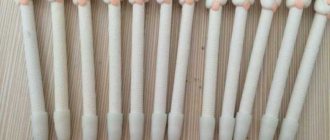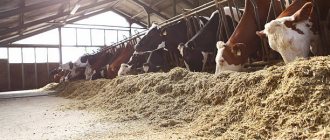Rabbits are used not only for meat and valuable skins, but also as pets. Today it has become fashionable to keep eared animals in apartments, walk with them on the street and even travel. A leash for a rabbit is a thing that the owner of the animal cannot do without; without it, it is impossible to let the pet play in the grass, otherwise it will run away. The article will tell you what requirements a leash must meet, what types of harnesses there are, and how to make walking equipment yourself.
Rabbit leash
Leash for a rabbit: how to put it on, how to make it yourself
It can be difficult to choose a leash for a rabbit in pet stores: they are rarely in stock, sell out quickly and often do not match the size of your pet.
In this case, it is quite easy to make a rabbit harness with your own hands. The materials for it are quite affordable and simple. We will explain step by step how to make a leash for a rabbit. First you need to measure the circumference of the pet's neck, chest and the distance between the chest and neck. Any soft fabric, long braid or thick threads are suitable for a harness. Cover the inside of the harness with fabric so that nothing rubs the animal. Connect the straps with a carabiner (4 cm long), you will also need several small rings for this.
Cut the braid into two strips. One strip is calculated as the distance between the neck and chest is 10 cm. The second: chest circumference, neck circumference 20 cm. Cover the second strip with soft lining fabric from the inside and make a double loop on one side into which the ring is threaded. Where there is a bend, a second seam is made - a buckle is attached to it.
Then all the parts are connected and the leash is secured. Your DIY rabbit harness is ready. All that remains is to accustom your pet to it and start walking. You will soon see that your animal is more active and healthy.
Materials and tools:
- a piece of thick fabric, it is better to take ready-made nylon braid;
- soft lining material;
- centimeter;
- scissors;
- needle and strong thread or sewing machine;
- buckles – 2 pieces;
- awl.
Rabbit leash
Step-by-step instructions for making a leash for a rabbit:
- We take measurements. It is necessary to measure the circumference of the animal’s neck and chest, as well as the distance between these parts of the body. We record the data on paper.
- Cut 3 pieces of braid. The first is 10 cm larger than the circumference of the animal’s neck. The second piece is 10 cm longer than the chest circumference. The third (connecting jumper) is 8-10 cm greater than the distance from the neck to the chest of the animal. The extra fabric will be used for seams.
- We cover all 3 fragments from the inside with soft fabric.
- On the first two fragments of the braid, we make a loop at one end and thread a buckle clasp into it. We make holes at opposite ends of the fabric using an awl. It is advisable to treat the perforation areas with threads or use special metal rivets so that the fabric does not fray.
- In the center of the jumper that connects the two straps, we make a loop and thread a ring into it. Subsequently, it is to this that the leash carabiner will be attached.
- We connect the three parts together so that the jumper is on the back of the animal.
Attention! The finished product should be tried on to ensure that the fasteners are adjusted correctly. If necessary, make 1-2 more holes on the straps if the harness does not sit tightly
To make it you will need the following materials and tools:
- centimeter for taking measurements;
- sewing machine;
- scissors;
- awl; braid;
- soft fabric for lining (for example, flannel);
- small diameter ring;
- sewing threads;
- buckle.
You can make a harness with your own hands by following the following instructions:
- We measure the ears with a centimeter. To do this, we take measurements of the circumference of the neck, chest, and the gap between them;
- then we measure and cut two strips from the braid. We calculate the length of one strip by summing the girth in the chest and waist area, and adding 20 cm to the resulting amount as a seam allowance. We calculate the second strip as the size of the gap from the animal’s neck to the chest plus 10 cm;
- we sew the lining to the first strip from the inside;
- make a loop at one end and place a ring in it;
- at the break point we lay another seam and attach a buckle to it;
- cut the other end of the braid into a bias;
- we pierce several holes one centimeter from the end of the cut using an awl;
- we hem the strip from the inside out and at the ends with lining fabric;
- then we connect all the parts and attach the leash.
There are now different types of harnesses for walking rabbits; you can even sew one yourself. The most convenient and reliable is considered to be a harness with a body in the form of a vest. A walk in the fresh air can be enjoyable for your pet, or it can be stressful for him. Be attentive to your little ear and the choice of place for walking.
How to make a harness for a rabbit: video
Do it yourself
There are many leashes, harnesses, and sets of both on sale. Although you don’t always find the right sizes and styles. If you wish, you can make the design yourself. It's not difficult, and some housewives even find it interesting. The main thing is not to forget about reliability and adhere to several rules.
Tools and materials
A harness and leash are simple products. Manufacturing does not require much time, effort, skill or money. The only materials you will need are the following:
- reliable braid, preferably made of nylon;
- dense but soft fabric for lining, for example flannel;
- buckles (clasps);
- ring and carabiner.
Use regular tailoring tools. Enough scissors, a ruler, a centimeter, a needle, strong thick threads, an awl, a pencil, and a piece of paper. It's good if you have a sewing machine.
Step-by-step instruction
This is how you make a rabbit harness with your own hands:
- The animal is measured. You need the girth of the neck, chest and the distance between them.
- Write down the numbers.
- Cut three pieces of braid. The length corresponds to the circumference of the neck, chest, and the distance between them. To each of these values, a margin of 10 cm is added. For example, the first piece will be equal to the circumference of the chest plus 10 cm. The margin is needed for seams.
- Each of the three pieces of braid is covered with soft, dense fabric, such as flannel.
- A neck strap is made. A loop is made at one end of the braid.
- A buckle is threaded through it.
- A hole is made at the second end of the piece of braid. They wield an awl. It is advisable to strengthen the hole so that it does not fray. This can be done using metal rivets or simply finishing the edges with thread.
- Sew a second strap - for the chest. They act the same way.
- A jumper is made for ready-made straps. A loop is made in its center.
- A ring is inserted there. Then there will be a carabiner for attaching the leash.
- Connect all three straps.
- They check it and adjust it according to the figure. Put on the pet.
- If it fits too loosely, you will need more holes in the straps.
The leash is made even simpler:
- A piece of the required size is cut from the same braid.
- A carabiner ring is threaded through one end and hung.
- Make a loop. It is secured with a rivet. The carabiner hangs on a loop.
- You can make another loop on the second side of the braid for convenience. This makes it easier to hold the leash.
Next, the structure is assembled. The carabiner on the leash is attached to the ring on the harness. The whole job takes little time, especially for an experienced seamstress.
Leash, harness and collar for a rabbit: how to put it on and make it yourself
Decorative rabbits are popular today. They are kept indoors and walked just like dogs or cats. For convenience when walking, you will need a rabbit leash. It's better to attach it to a harness.
Why does a rabbit need a leash?
The animals are active and curious. To feel normal, they need movement, walks, preferably outside, in the fresh air.
Letting a rabbit go unattended is dangerous. This is a shy animal, and there are many enemies around, such as dogs. You can walk together, but no matter how much the animal loves its owner, it will most likely run away. Especially if he is afraid of a car or something else.
A safe option is supervised walking. That's what a leash is for. It is more common to see it on dogs. It is essentially a rope that is attached to a collar or harness. Sometimes a roulette leash is used for rabbits. This gives greater freedom of maneuver.
The leash usually comes with a rabbit harness. A collar, on the contrary, is usually not used for the following reasons:
- Leads to injury. With a strong, sudden pull, you can strangle your pet or cause injury, since the neck muscles of rabbits are poorly developed.
- It is easier for the animal to escape. When in danger, he can dodge in the most unimaginable ways.
Instead of a collar, they take a harness - a special device made from belts. It secures the chest, part of the back, and neck. The leash is usually attached near the withers. The load falls on this area and is evenly distributed over the front of the body. The neck does not suffer.
How to put a harness on a rabbit
The products are easy to put on. However, without habit there are difficulties. Plus the rabbit puts up resistance. To make it easier, study the design in advance.
If you look at the rabbit from the side, the harness on resembles the letter “n”. For rope models, the order of putting on is as follows:
- Inspect the straps.
- The smaller one is placed around the neck and fastened. The index finger should pass between it and the body. Do not tighten the strap loosely, otherwise the animal will free itself. You don't need too much either. This causes discomfort.
- The larger strap of the harness is placed over the stomach. Fasten it up. Check that the fastenings do not pinch the skin or fur.
For products with a body, the procedure is even simpler:
- Apply to the rabbit's back.
- Wrap the body.
- Fastened with Velcro and fasteners.
- Check that the vest fits well: does not dangle or pinch.
How to train a rabbit to wear a harness
It is advisable to practice before your first walk on a leash. Rabbits are shy animals. Exercising will relieve you of unnecessary stress. It takes several days, sometimes a week, to get used to the harness and leash. They do the following:
They collect the rabbit “for the road”. At first, use only a harness without a leash. The animal runs around the house for several minutes. Trying. The “load” time is gradually increased. Attach a leash. They are still walking around the house. They wait for the animal to get used to the harness and leash. They go outside. Choose good weather and a quiet place
It is better to use a carrier and then release the animal. They walk carefully. Do not make sudden movements, do not pull on the leash
They provide psychological support to the rabbit: they encourage them with their voices, they pet them. Gradually the pet becomes bolder. Sometimes they give him the illusion of freedom: they tie him to a peg or attach a roulette leash.
While walking, do not forget a few more rules:
The harness does not guarantee complete safety. It does not protect against injuries 100%, especially rope. In case of stress or attempts to escape, sometimes pinching, damage to internal organs, and fractures occur.
Be careful.
They don’t necessarily walk near the house. Carrying helps you go outdoors.
Rabbits are active animals
If an animal does not run, but only sits or lies down for a walk, this is not normal. Most likely, the animal is stressed. The pet is calmed down and returned home.
Before the walking season begins, the rabbit is vaccinated. There are a lot of germs and parasites outside, including in the grass.
Cold, wet or hot weather is detrimental to a rabbit's health. Colds, heat strokes and other problems are possible.
Rabbits require movement and fresh air to live a normal life. Even in the city you can give them useful and interesting walks. All you need is a harness and leash.
Types of rabbit harnesses
Choose a product according to your taste. Harnesses are safer than collars. Although among them there are more reliable and successful options. There are two main types: rope and with a body. They produce special harnesses and leashes for rabbits. Although small models are also suitable for cats or dogs.
Rope
One type of harness is made from nylon straps. The rope design forms two large loops: on the chest and on the neck. Each one is individually fastened. These two straps are connected by a bridge that runs along the rabbit's back. This is where the leash is attached.
Rope models are not particularly comfortable or reliable. If you put it on carelessly or ineptly, there will be more shoots. When purchasing, pay attention to the following:
- Suitable size. If the harness is too large, it is easier for the rabbit to escape, but if it is too small, it will choke.
- Reliability and safety of fasteners.
- It is better when the leash is not tightened, but is fastened with a carabiner.
However, this is a simple and inexpensive option. Rope harnesses are popular and common.
With housing
Similar models are also produced in the form of a kind of rabbit clothing. These are harnesses with a body that look like a vest. They are made from thick fabric. There are fasteners or Velcro in the belly and neck area. A leash is attached to the top.
Products with a body are more convenient than rope models for both animals and owners:
- Cool evenings are not scary in such vests.
- Made from soft fabric that does not rub.
- Easy to put on and adjust the size.
- The load is well distributed. You can even lift the rabbit by its leash. If everything is put on correctly, there will be no harm to health. This is convenient, for example, in case of danger.
How and where to walk rabbits in a harness
The video shows how to put on a harness for a rabbit, and in what conditions it is better to walk it.
- If you decide to walk your pet, then initially he needs to be vaccinated to protect him from common dangerous diseases. For a walk, you should choose a quiet place where the animal will not be disturbed by noise and passing traffic, barking dogs, etc. A great place for a walk would be the territory of your dacha, if you have one. In this case, it’s even worth purchasing or making an enclosure for walking.
- The rabbit should be carried in a carrier to the place of walking. You should walk in warm weather - cold, wind and slush can negatively affect his health. In the summer heat, walks should be taken in the morning or evening, when the direct rays of the sun cannot harm the animal and it is not so hot outside.
- During exercise, you should monitor your pet so that it does not get tangled in the leash and harm itself. Make sure that the greenery growing in the walking area does not contain poisonous herbs. The following herbs can cause poisoning in a rabbit: cockle, hemlock, celandine, foxglove, buttercup, spurge, wekh, dope and others.
Important! Predatory animals can scare rabbits to death - these little ears do not tolerate stress well. Therefore, if you see a large dog barking loudly in a walking area, you should look for another place
It is recommended to carry the baby rabbit to the place of walking in a special carrier designed for pets. This reduces the likelihood that the animal will get tired or get hurt. The little rabbit does not obey commands like a dog and walks in the direction it chooses independently
You should behave carefully with it, since many things can frighten the animal, as a result of which it can begin to break free and run away
The preferred place for walking is the lawn
Since in nature rabbits are in constant motion, it is recommended to use a roulette leash, which will limit the animal’s walking radius at any time without scaring it. If the animal does not move, sits with its ears down and pressed to the ground, it is frightened by something. At such moments, the owner should pick up the rabbit and talk to it in a gentle voice to relieve stress and calm the animal.
It is not recommended to walk with pets outdoors in low air temperatures and winds, as there is a risk of catching a cold. The optimal time for walking is considered to be morning or evening in the warm season, so that the animal does not get sunstroke. If the summer evening is a little cool, the rabbit should dress up.
Is it possible to walk a rabbit on a leash?
In the summer, when the street is full of lush green grass, many rabbit owners want to take their pet for a walk. You can walk pets, but only on a leash. Rabbits, especially decorative ones, are very shy. Any slight noise can cause animals to run away. It won't be easy to catch them.
It is better to put a comfortable harness on your pet before going for a walk. Experts do not recommend buying a leash with a collar for decorative breed rabbits. These animals have a thin neck and fragile cervical vertebrae. A collar that is too tight can cause the rabbit to choke, but a collar that is too loose can throw it off. But a leash with a harness that covers the neck and chest of a small animal is an excellent purchase for a walk.
If you go for a walk with a decorative rabbit, then only on a green lawn. It’s better not to drive an animal on asphalt; it’s not a dog. Rabbits are very shy and need silence. A huge number of people can cause stress in pets. It is advisable to walk animals in uncrowded places (in a park, in a country house, outside the city, in rural areas). You can only go outside in warm sunny weather. It's better to stay home when it rains. Rabbits are not allowed to eat wet grass. Dry is possible, but you need to make sure that the animal does not eat poisonous plants.
Expert opinion
Zarechny Maxim Valerievich
Agronomist with 12 years of experience. Our best country expert.
Ask a Question
Important! You can only walk with your rabbit once it reaches 4 months of age. Before the walk, the pet needs to be vaccinated against myxomatosis and hemorrhagic disease, wait 4 weeks for the animal to get stronger after vaccination.
How to wear a harness correctly
How to put a harness on a rabbit if it is being put on for the first time? Be prepared for the animal to squeak and resist. You need to talk to him affectionately, while holding him tightly in your hands. When the rabbit calms down a little, you can continue to dress it, while still talking to it affectionately.
The harness is fastened in two stages: on the neck and on the chest. The rabbit should be comfortable in the new outfit. A finger should fit between the neck and the harness, and the clasps should be tightly fastened.
Important! Be careful not to pinch the animal's hair or skin with the fasteners. If all conditions are met, the animal does not feel the harness on its body, and accordingly, it cannot cause him any inconvenience.
After it is put on the rabbit, you can attach the leash.
If the animal feels calm and safe, walks will undoubtedly bring him a lot of positive emotions. He will be able to move freely on the lawn, while being in full view of the owner.
Which harness is suitable for a pet rabbit?
To make the animal feel comfortable, you should choose a comfortable and reliable leash (harness) for it. Rope devices should not be used for walking rabbits. The pet can easily jump out of them and run away. In pet stores you can find many different devices for walking animals. You just need to choose the required size, comfortable fasteners and a leash.
A high-quality leash around the neck should be fastened, not tightened. This is necessary so that a rather cowardly animal, frightened by the noise and trying to free itself, cannot accidentally strangle itself.
If you look at the animal from the side, the jumper of the leash should form the letter “H”.
A regular harness consists of two open rings. To put it on, you should pick up the rabbit, put a small ring on its neck and fasten it. The second belt is passed under the stomach, where it is then fastened. A carabiner leash is attached to the back. The harness should not dangle, but it should not be fastened too tightly. A finger should pass between it and the animal’s neck.
Such harness designs are only available for rabbits. But small leashes designed for dogs and cats are also suitable for them.
A harness is the best leash option for a rabbit. In it, the animal will not squeeze its throat when frightened, and it will not be able to get out of such clothes. The rabbit will feel quite comfortable in the mesh structure. Its advantage is that in times of danger the animal can be calmly lifted by the leash and picked up.
Description of the leash
A leash for a rabbit is different from leashes for dogs or cats. This animal has significant behavioral and anatomical characteristics, which further differ depending on the breed and size. Therefore, ordinary leashes will not work. Unlike dogs, which are guided by the behavior and commands of the owner while walking, a rabbit, when frightened, will try to escape. This can lead to injury, internal and external damage, or even suffocation of the animal.
Rabbits need a harness that takes into account the anatomy of the animal. In this case, the leash should be located on the back, and not on the neck.
Also, don’t forget that your furry little eared dog needs to be accustomed to wearing a harness from an early age. But, first, the little rabbit must get used to its owner and his hands. The animal should not be afraid of your smell or the sound of your voice. The new situation and environment should not frighten or alarm the animal. When you see that the baby is not afraid of you and feels your protection, begin to accustom him to the harness.
First, walk around the house with the rabbit, gradually increasing the time spent on an unusual leash, then in a quiet park on the grass. But street noise can frighten the animal for the first time. Therefore, at first, also accustom your fluffy to new sounds and smells of the street. It is better to do this in a sparsely populated park, away from roads and crowds of people. Let the animal spend its first walk in the air in your arms.
When teaching a leash, do not tighten it so that the rabbit does not start running around in fear, trying to escape. If trained incorrectly, he may even abandon the harness during walks. If you did everything patiently, without haste, and without stressing the animal, four to seven days is enough to get used to the leash.
It should be remembered that walking on the grass, even in the most environmentally friendly place, can become a source of infection for your pet. Remember, before you let your rabbit walk on fresh grass, it is necessary that the animal is vaccinated on time. This is necessary so that immunity to pathogens can develop.
Why does a rabbit need a leash?
Long-eared rodents are active animals; they love to move and play a lot. This lifestyle is good for them. Walking in the warm season also helps the animal stay healthy. Fresh air is one of the main conditions for strengthening the immune system. However, it is impossible to walk with a rabbit without a leash. These animals are very shy. When they hear a loud sound and find themselves in an unfamiliar environment, they experience great fear. During a walk, the animal may get scared and run away. To prevent this from happening, you will need a leash.
What is a harness?
The first accessories, similar to a harness, were used in ancient times in dog sleds. Currently, dog harnesses are attributes in the form of two straps that pass through the chest along the body. They connect on the pet's spine, as well as between the front legs.
According to experts, this accessory is more acceptable than a collar. A dog harness allows you to evenly and correctly distribute the load across the animal’s skeleton. In this accessory the animal feels more comfortable and calm. Moreover, the pet owner has the opportunity to fix the dog in the required position.
But if previously hand-made leather dog harnesses were used exclusively in sledding, today their scope of application has expanded. Most breeders choose these attributes because they allow for reliable control of the animal without affecting its throat. But if the dog is not trained, then he can also show his temperament in a harness. That is, you should not hope that he will stop struggling while wearing a harness during a walk.
Advantages and disadvantages
Let's start with the advantages:
- You can control your pet well without letting it run away.
- The breeder will have the opportunity to adjust the distance between him and the animal.
- A dog harness is an excellent option for teaching your pet to use a leash, which is why it is often used by dog owners while the puppy is at an early age.
- Special cargo attributes, which can be made with your own hands, are perfect for training.
- The attribute can be sewn with your own hands at home.
The accessory also has disadvantages:
- If the dog is very active and does not allow you to put a harness on him (which is often the case with puppies), the process may take some time.
- If at least one fastener is not securely fastened, this may lead to the dog simply breaking loose during a walk and running away.
- Materials that are too soft will tear quickly, especially if your pet is a large breed.
- If you don't switch to it in time, it will quickly get used to it. Accordingly, it will be more difficult to translate it.
Rules for safe walking
Before you go for a walk with your rabbit, you need to give it a chance to get used to the new object. First, the harness is worn at home for a short time. There is no need to attach a leash to it, let the animal get used to it. If you increase the time you spend in the harness every day, your pet will soon get used to it.
Rabbit on a leash
You can walk with the animal in warm weather, when there is no precipitation or strong gusts of wind. It is worth choosing places where it is quiet and calm, because rabbits are very afraid of noise and crowds of people. In case of danger, the owner of the animal can lift it directly by the leash without fear of causing injury to it. A rabbit leash supports him under his front legs and chest, not behind his neck.
Important! You can walk with your rabbit starting from 4 months. The animal must be vaccinated in advance with vaccines against myxomatosis and VGBV, as well as against rabies.
If a long-eared pet has recently appeared in the house, you need to think about getting a leash for walking. These animals need to exercise a lot and breathe fresh air to stay healthy. Don’t despair if you don’t find a harness of the right size in the store, because you can make it yourself.
fermhelp.ru
How to train a rabbit to a harness
First, you need to wear the harness at home. The first time the rodent should stay in it for up to 5 minutes. With each subsequent time this time needs to be increased. They do this at home until the rodent stops trying to remove it. It usually takes about 6 days. After getting used to it, a leash is attached to the harness.
If the animal is easy to control, he is not nervous, and he is comfortable, you can take him outside, but not for long at first. Stay close to him and monitor his condition. During the first walks, it is recommended to allow the rabbit to choose its own territory.
Did you know? The maximum recorded length of a rabbit's ears is 80 cm.
Harness training for your rabbit should begin as early as possible. The process of addiction itself takes 5–7 days. First, the harness is put on the little ears at home. When it is first pulled on, he only needs to stay in it for a few minutes.
Did you know? The smallest rabbits on Earth are pygmy rabbits, which live on the North American continent. In adulthood, they gain weight no more than 400–450 grams and grow in length up to 22–35 cm. They are now on the verge of extinction.
At first, when walking outside the house, you do not need to move away from your pet or pull its leash. The animal may get scared and not want to go for walks. For convenience, it is recommended to buy a roulette leash. With such a leash, the animal will no longer notice that it is on a leash. All elements are put on without coercion, so that the rabbit does not develop a negative attitude towards them.
We train your pet to wear uniforms
It is recommended to accustom your eared pet to a leash and harness as early as possible. This must be done slowly. The procedure itself can take from four days to one week.
Initially, it is better to put on the harness in the usual home conditions, giving the rabbit the opportunity to stay in it for only a few minutes. Every day the amount of time increases. When the eared dog stops responding to it, you can fasten the leash, but don’t use it yet.
Let the leash follow the moving rabbit along the floor or ground. Over the course of several days, the training time should also be gradually increased. Only after the animal gets used to such ammunition can it be carefully taken out of the room and into the street. At first, it is better not to move far from the animal, especially not to pull the leash with force.
You can choose a quiet, safe place covered with tall grass, drive a small stake and let the animal enjoy nature. At the same time, it is better not to let him out of sight. The harness must be put on carefully and gently so as not to cause fear, anxiety, pain or discomfort in the animal.
He should associate this procedure with subsequent pleasant pastime, so it is recommended to walk the rabbit in calm, clear weather. For a greater sense of freedom, you can use a roulette leash.
How to properly put a harness on a dog
There are several proven ways to put a harness on a puppy step by step. The choice depends on the size of the dog.
For large dogs
When using a conventional product in the case of a large dog, the diagram looks like this:
- Prepare the product, study its design and instructions for use.
- Check the functionality and strength of the latches or locks.
- Securely secure the dog. To do this, you need to sit down a little and wrap your legs around her body. If the baby is too active, then you can lay him gently on his back.
- Take the harness in your right hand, then grab the dog in the chest area.
- Secure the pet with your left hand. Gently lift your left paw and bend it at the elbow.
- Quickly insert your paw into the hole between the two circular straps.
- Pull the harness slightly towards your chest and grab it with your left hand.
- Repeat everything for the right paw.
Dogs quickly get used to the harness and refuse the collar.
When doing the work step by step, you need to be careful. If the work is done correctly, the harnesses will not intertwine with each other. You can tighten or loosen the straps using special clamps.
Important! Be sure to check how tightly the lock is fastened
For small breeds
For small dogs, the harness is usually worn in a different way. The instructions look like this:
- The condition of the harness is checked: the straps should not be intertwined, and the lock should be secure.
- The product is placed on the ground, after which it is completely straightened out.
- If the dog is very small, then you can simply hold it in your hands.
- The dog is placed with its front paws in the corresponding holes.
- The harnesses are intercepted and quickly pulled up, after which the lock snaps into place.
The final stage involves checking the condition of the harnesses, the degree of tension of all straps and the reliability of the latches and locks.
Riding models
On sale there is a version with two holes, which are intended for the head and torso. They are often called sleds. Recommendations for use are as follows:
- The product needs to be inspected: even minor defects in the fasteners can cause the pet to break out.
- You need to sit down behind the dog and use your feet to slightly hold the body in the area of the hind legs.
- Place your head through the hole intended for the chest.
- Arrange the straps so that the holes for the paws are conveniently located.
- Raise the right front paw slightly, then bend it at the elbow and insert it through the hole.
- Fasten the belt at the side.
Next you need to check the condition of the lock. The leash must be attached to rings made of durable material.
The longer the leash, the more comfortable the pet is on a walk.
Product in the form of a vest
Recently, harness options that look like a vest have become very popular. They also fasten at the chest.
You can put on such a vest as follows:
- The dog's body is fixed with its legs. The pet must be motionless, otherwise there is a risk of harm.
- The vest is placed on top, it should cover the back.
- One of the front paws is raised slightly, bent at the elbow and pushed through the hole.
- A similar action is repeated with the second paw.
- The vest fastens quickly, the dog must not be released.
The dog may struggle, whine or squirm. In most cases, this is due to the fact that the pet is afraid of new things. This can only be avoided with timely and correct taming.
The choice of product width is influenced by the weight of the dog.
Sewing harnesses at home
As rabbits become increasingly popular as pets, the demand for clothing and harnesses for them has increased. Today there is a large variety of uniforms for rabbits, but they can also be made at home. You should know a few nuances, and the pattern can be made according to step-by-step instructions.
You can sew your own harness
Rabbits have a different body structure from cats and dogs. Dogs and cats have a less massive rear end and a wider chest, so the range of clothing and uniforms designed for these animals is not suitable for rabbits. The latter also differ in size. If for some reason you cannot purchase a harness of the required size in a specialized store, you can make it yourself at home. For this you will need:
- Braid;
- Centimeter;
- Strong threads;
- Leash attachments;
- Plastic ring;
- Scissors;
- Buckles;
- Lining fabric.
The pattern is simple. First you need to take measurements from the rabbit. For sewing you will need the following data: chest circumference, neck size, distance between the neck and chest. When the measurements are taken, you can cut the braid into two parts, one of which should be 15 cm larger than the neck girth, and the second should be the same amount larger than the chest girth. Each part should be covered with fabric that was intended for lining. Next you need to attach the clasp. The next piece of fabric should be 6 cm longer than the distance from the withers. It should also be lined with lining fabric on the inside. Using this cut, you need to connect the two previous fragments of the harness and sew a ring for a carabiner with a leash to it. The animal will be comfortable wearing a harness sewn according to this pattern.
How to properly put a leash on your pet
Putting on a harness made from straps is simple: you need to put a smaller ring on the rabbit’s neck. It will hold the animal in place with minimal girth. Pass the second belt under the lower abdomen and fasten the ring on it. Attach the leash carabiner to the strap on your back. If the harness is worn correctly and has a good design, on the side of the animal the joints of the straps form the correct letter “H”.
The harness-clothing is simply fastened first on the stomach, and then on the rabbit’s neck.
A self-made harness is put on differently: the front legs are threaded into the harness ring so that the ribbon dividing the ring runs along the tummy. The sides of the ring are connected at the back with a leash carabiner.
If you purchased or made your own rabbit harness and managed to put it on correctly, feel free to go for a walk with your pet! Do not forget that the time of year should be warm, the place for walking should be quiet and safe. Then you and your furry and eared family member will fully enjoy the walk.
Tools and materials for making harnesses
For proper maintenance, a harness for a rabbit is of great importance. This is especially true for apartment buildings. The range of leashes of the required sizes and quality in most zoological stores leaves much to be desired. Therefore, for many owners of ornamental animals, it is relevant to make such walking accessories with their own hands.
To do this, you will need tools such as scissors, an awl, a sewing machine, and a centimeter. In addition, the materials needed are threads, yarn, braid, soft fabric, and several small rings.
It is important to choose soft, “friendly” materials for your rabbit’s skin. For example, flannel or drape. It is not recommended to focus on the rope structure, since it is not very reliable.
What to look for when purchasing
A proper harness should fasten around your pet's neck and not be pulled tight. In this case, if a cowardly furry animal, frightened by the noise, starts to break free, it will not be able to accidentally strangle itself.
Put a harness on the rabbit and look at the pet from the side. If the jumper of the leash forms the letter “H”, then the harness is chosen correctly.
A typical harness for walking a pet consists of two open rings. To put on the walking device, you need to take the rabbit in your arms, put a small ring on the pet's neck and fasten it.
The leash carabiner is fastened to the back, the harness should not dangle, but it should not be fastened too tightly: a finger should fit between the harness and the pet’s neck.
When choosing a walking harness for your pet, you should pay attention to the following aspects:
- sizes. The harness should fit the rabbit well and not be too tight or loose;
- reliability. The fastenings of the structure and the material itself should not be damaged under loads and withstand the active movements of pets;
- clasp. It should be fastened and unfastened comfortably and securely;
- material. Must be harmless to the animal and wear-resistant;
- leash. Should be securely attached to the middle of the back. This arrangement is most convenient and safe for a nimble animal. The most acceptable option for rabbits is a roulette leash.
How to choose the right one
It is better to come to the pet store with your rabbit and try on the harness. You can bring your pet in a carrier bag or a lightweight plastic container. If it is not possible to come to the store with your favorite animal, you can buy a harness without it. The main thing is to choose a product of the right size.
The straps should not pull the rabbit's body too tightly or, conversely, hang loosely on the animal's body. You can measure the girth of your pet’s neck at the location of the collar and the girth of the chest behind the front legs at home, and with these results come to the store and choose the equipment of the right size.
Why does a cat need a collar, leash or harness?
Even the most phlegmatic domestic cats are happy with the new experiences that a walk gives. And if your pet has an active temperament or has lived on the street in the past, he may feel sad, sitting in the apartment all day long. In order to make walking with your cat safe and comfortable, special devices come to the rescue: a collar, a leash and a harness.
Walks give cats many new experiences
Collar
Some owners purchase anti-parasitic collars for their cats, which the pets even wear around the house. But for a walk you need a more reliable collar with a strong clasp.
If your cat walks, as the saying goes, on its own, you need to choose a comfortable collar for it that will not allow the animal to get caught on protruding dangerous objects and will not fly off during active movements. In addition, the collar must have a mount for an address book on which you can write the cat’s name, your phone number or address. If the pet gets lost or gets into trouble, the people who find it will be able to return the poor thing home. When deciding to walk an animal on its own, you need to be aware that it is unsafe.
The pet's collar must have a tag with the owner's number on it.
An option in which you can not worry about your pet, but at the same time give him the joy of a walk, is to use a collar in tandem with a leash.
Leash
As mentioned above, a leash is the key to a safe walk with a cat. It is best to opt for a long but strong leash. A chain, unlike dogs, is not suitable for cats - it is heavy and can scare your furry or cause him pain.
The cat's leash should be soft and light
And, of course, even when walking on a leash, put a tag with contacts on your cat’s collar - just in case.
What is a harness for?
Recently, rabbits have become increasingly popular as pets.
These are quiet and calm animals that do not require special care. Decorative breeds are not pests. They are pleasant to feed, interesting to play with, but walking with them is especially enjoyable. For a walk, a baby rabbit needs a quiet place with green, soft grass, away from noisy highways and any loud sounds. To be able to control the animal, a harness is put on it. A harness for a rabbit is designed to prevent it from running away or getting injured. It is less safe to put a collar on a rabbit. If you put on a collar and do not calculate your strength, pulling it can cause harm to the health or life of the animal. The harness does not put pressure on the neck or block the airways, so it is considered more useful when walking rabbits.
Rabbit Harness
What types of harnesses are there?
Harnesses for walking rabbits can have different designs and be made of different materials.
Find out how to care for a decorative rabbit in an apartment.
Rope
Made from nylon rope-straps. The construction of such ropes should not be tight or have tightening knots and elements. The clasp should be simple and convenient. At the same time, such a harness should not be loose, it should be adjacent to the body so that the pet does not slip out of it.
The advantage of this option is that the product made from straps is quite cheap.
Important! A rabbit will react very differently to an attempt to walk on a leash than a dog. This situation may be very stressful for him and he will not get any benefit from the walk. If he lies on his stomach and does not show any interest in the environment, then the walk should be stopped and not repeated.
With housing
The option in the form of a vest is more convenient and reliable - the animal will not get out of it on its own and such clothing will not harm the pet in any way, no matter how it behaves. It is also easier for a person to use, since such a harness is most convenient for pulling this frisky animal towards you.
Basic selection rules
To choose a safe and high-quality leash, you need to follow some rules and pay special attention to the design elements:
- The leash is attached in the middle of the back.
- Fastenings and fabric should not be damaged during use (come loose, tear).
- Choose natural fabric from environmentally friendly material.
- The design must be true to size.
- The clasp is easy to use, quickly opening and closing.











